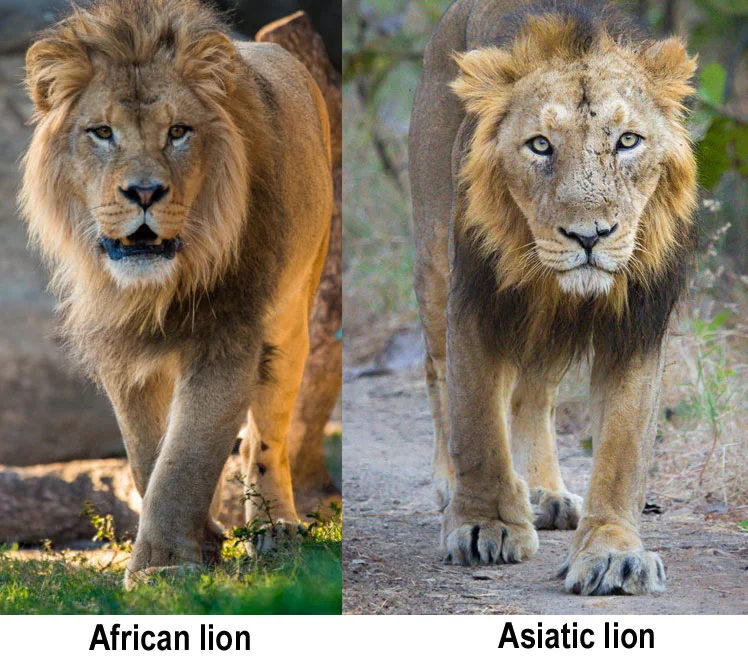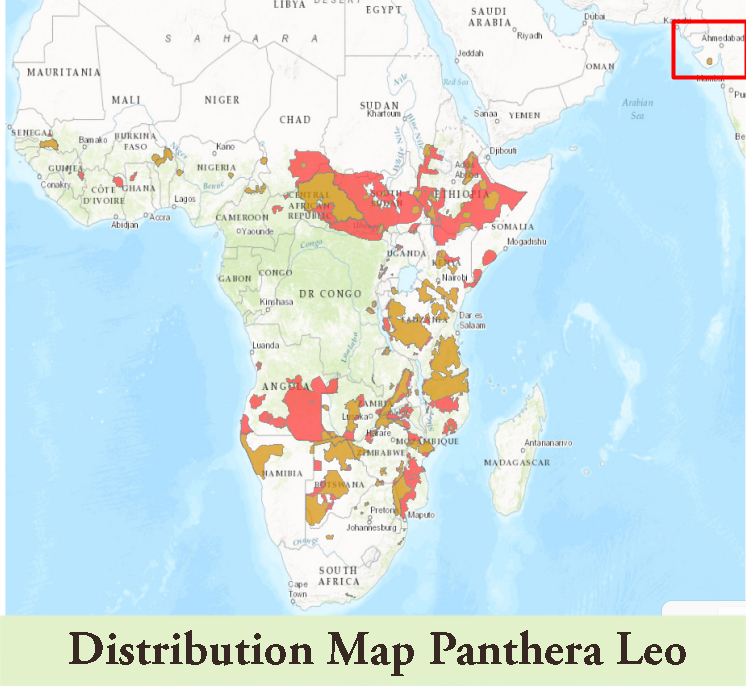Important Facts For Prelims
South Africa to End Captive Breeding of Lions
- 08 Apr 2024
- 4 min read
Why in News?
Recently, South Africa has decided to end captive breeding of lions (Panthera leo) due to concerns over trophy hunting and the use of lion bones in traditional Chinese medicine marks a significant shift in wildlife conservation.
What are the Key Traits of Lions?
- Subspecies: There are two subspecies of lions found in the wild. The African lion (Panthera leo leo) and the Asiatic lion (Panthera leo persica).
- African lions used to be spread across most of the African continent, but now are only found in sub-Saharan Africa, with 80% in eastern or southern Africa.
- Asiatic Lions are found at Gir National Park and Wildlife Sanctuary in Gujarat, India.
- Although both subspecies of lions look very similar, there are some differences.
- Male Asiatic lions tend to have darker, shorter manes compared to African Lions.
- Additionally, both male and female Asiatic lions are smaller than African lions.
- African lions used to be spread across most of the African continent, but now are only found in sub-Saharan Africa, with 80% in eastern or southern Africa.
- Habitat: They are most active at night and live in a variety of habitats but prefer grassland, savanna, dense scrub, and open woodland.
- Social Structure: Lions are the most social big cat, living in groups called prides.
- A pride typically consists of several related females, their cubs, and a few adult males (coalition).
- Lionesses are the primary hunters, while dominant males are responsible for protecting the pride's territory.
- Hunting and Diet: Lions are apex predators and primarily hunt large ungulates like wildebeest, zebra, and antelope.
- They typically hunt cooperatively, using their agility and teamwork to take down prey.
- Also, lions are opportunistic feeders and will not hesitate to scavenge when the opportunity arises, often stealing kills from other predators.
- Threats:
- They face a multitude of threats from habitat loss and fragmentation to climate change and the reduction of available prey.
- They are also targeted by trophy hunters.
- Trophy hunting is a form of hunting where the primary goal is to kill animals for their body parts, such as horns, tusks, or skins, which are then kept as trophies or souvenirs (and not primarily as food).
- Conservation Status:
- IUCN Red List: Vulnerable
- CITES: Appendix I
- Wildlife Protection Act 1972: Schedule I
Note
- In India, Project Lion envisages landscape ecology based conservation of the Asiatic Lion in Gujarat by integrating conservation and eco-development. The Gujarat government has planned to translocate 40 adult and sub-adult lions to the Barda Wildlife Sanctuary in the state, according to a 2023 report by Wildlife Institute of India (WII).
UPSC Civil Services Examination, Previous Year Question:
Prelims:
Q. Consider the following statements: (2019)
- Asiatic lions are naturally found in India only.
- Double-humped camels are naturally found in India only.
- One-horned rhinoceros is naturally found in India only.
Which of the statements given above is/are correct?
(a) 1 only
(b) 2 only
(c) 1 and 3 only
(d) 1, 2 and 3
Ans: (a)
Q.2 Recently there was a proposal to translocate some of the lions from their natural habitat in Gujarat to which one of the following sites? (2017)
(a) Corbett National Park
(b) Kuno Palpur Wildlife Sanctuary
(c) Mudumalai Wildlife Sanctuary
(d) Sariska National Park
Ans: (b)






